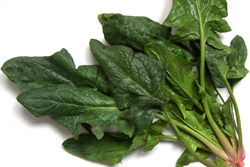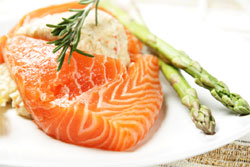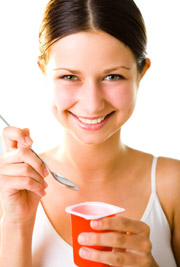- Introduction to nutrition for healthy skin
- Free radicals and antioxidants for healthy skin
- Minerals for healthy skin
Other nutritional considerations for healthy skin
- Foods to avoid for healthy skin
- Summary points
Introduction to nutrition for healthy skin
Many people are concerned with not only their general health, but the health of their skin as well. Getting the best nutrition you can is essential for maintaining healthy skin. Indeed, though it is impossible to prevent the process of ageing skin, good nutrition can help maintain an attractive complexion.
Human skin requires nutrients to flourish. These can be obtained from a healthy diet and through multivitamin supplementation. There is no doubt that your wellbeing, including skin health, can be enhanced by eating healthy foods such as fruits, vegetables, grains, nuts and fish. The use of supplements (e.g. vitamin A) can also help maintain healthy skin.
Scientific studies have shown that a diet rich in fruits, vegetables, nuts, yoghurt, eggs, vegetable oils, whole grains, tea and water results in less photo-ageing and skin wrinkling than diets that include red meat, whole milk, butter, sugary products and potatoes. To better appreciate the role diet plays in maintaining healthy skin, a basic understanding of how free radicals destroy our cells and how antioxidants work to protect against cell damage will be useful.
Free radicals and antioxidants for healthy skin
Free radicals are atoms or molecules with odd (unpaired) electrons that are usually highly reactive. Free radicals are generated in our bodies during normal metabolism. They can also be created by your body’s immune system in its attempt to fight against viruses and bacteria. Sometimes, environmental factors such as pollution, radiation, cigarette smoke and herbicides can also trigger the formation of free radicals.
 |
For more information on smoking and its health effects, and some useful tools, videos and animations, see Smoking and The Effect of Smoking on Skin Health. |
The damaging effect of free radicals accumulates as one grows older. Free radicals can be formed when oxygen interacts with certain molecules. As the skin ages, its main components oxidise due to exposure to free radical oxygen molecules. These oxygen molecules have lost an electron from natural metabolic processes, and are in continuous search for weaker cells of the body to take up one of their electrons. Once a healthy cell has lost an electron, it becomes weakened. Free radicals can cause extensive DNA damage over time, causing the cells to die and the organism to age.
Antioxidants are chemicals that protect cells by neutralising the effects of factors such as the sun, pollution, wind, temperature, emotions, metabolism and excess oxygen. Common antioxidants are vitamins A, C, E, and beta carotene. The special function of antioxidants is to protect your cells by fighting free radicals. They engulf free radical cells, thereby counteracting their attacks and eliminating them from the body.
Antioxidants strengthen cells and make them more resistant to free radical attacks on their electrons. They protect collagen and elastin cells from being destroyed, and also help to prevent cell and tissue damage that could lead to cellular damage and disease. Antioxidants neutralise the effect of free radicals by donating one of their own electrons, thereby curtailing the electron-seeking behaviour of free radicals. They don’t become free radicals as a result of donating an electron because of their inherent stability.
The cellular damage caused by free radicals makes cells more susceptible to attack from bacteria and other factors that trigger the ageing process. The efficiency with which the body deals with free radicals is an important factor in determining the longevity and health of body cells.
How does the body handle free radicals? Fortunately, some nutrients such as vitamins, minerals, antioxidants and others nourish the skin. These nutrients can be obtained as supplements, from your diet, or can be applied directly to the skin.

Yellow fruits and leafy green vegetables are rich sources of vitamin A. Additionally, applying creams containing vitamin A to the skin can enhance healthy skin and help control acne.
Of all the B vitamins, biotin (vitamin B7) is the single most important found in the skin. Biotin deficiency may cause dermatitis (an itchy, scaly skin reaction). Biotin is abundant in many foods, including bananas, eggs, oatmeal and rice. The body is also able to make some biotin on its own.
Topical cream preparations containing B vitamins can help give skin an almost instant healthy glow, while hydrating cells and increasing overall tone. Niacin (vitamin B3) in particular helps skin retain moisture, so creams containing this nutrient can help your complexion look plumper and younger in a very short time. Niacin also has anti-inflammatory properties that can soothe dry, irritated skin. In higher concentrations, it can also work as a lightening agent to even out blotchy skin tone. Applying topical vitamin B has been shown to dramatically improve ageing in human skin.
Your body cannot make its own vitamin C, but it is necessary for collagen maintenance. The main components that support the structure of the skin, collagen and elastin, are destroyed by free radicals, leading to the development of wrinkles.
Getting enough vitamin C will therefore help maintain healthy skin. Rich sources of vitamin C are citrus fruits and vegetables such as oranges, lime and lemon. Strawberries, tomatoes, sweet peppers, green peas, bell peppers, broccoli, cauliflower and leafy greens are also good sources.
You may also apply topical vitamin C cream to stimulate collagen production. The best creams for healthy skin are formulations that contain the L-ascorbic acid form of vitamin C, the only form that can penetrate skin layers and enhance collagen production.
Vitamin E is an antioxidant that can help protect the fat component of the skin from the damaging effects of free radicals. Applying body lotions that contain vitamin E can help protect against the effects of sun exposure, and can soothe dry, rough skin. In combination with vitamin C, vitamin E also provides protection from the damaging effect of ultraviolet (UV light). Additionally, factors associated with DNA damage in the skin appear to be reduced with improved antioxidant vitamins status. Vitamin E helps slow down the conversion of soluble collagen, which is predominant in youthful skin, into insoluble collagen, which is characteristic of ageing skin. Supplementation with natural vitamin E can improve skin texture.
Rich dietary sources of vitamin E are vegetable oils, peanuts, seeds (e.g. sunflower), olives, broccoli, spinach and asparagus.
Supplementation with vitamin E may be necessary to help you get enough vitamin E. However, large doses of vitamin E can be harmful and should be avoided. To be on the safe side, the recommended daily intake of vitamin E is 400 IU or less.
Minerals for healthy skin

Selenium is a mineral antioxidant that will help minimise damage caused by ultraviolet light. Scientific evidence suggests that selenium plays a key role in skin cancer prevention. Taken either as a supplement or used in a cream, this mineral helps protect skin from sun damage. If you spend any time in the sun, selenium could help reduce your chance of burning.
The best dietary sources of selenium include tuna, wheat germ, sesame seeds, nuts, broccoli, Brussels sprouts, mushrooms, whole grain cereals, seafood, garlic and eggs.
In the presence of vitamin C and zinc, copper helps promote elastin growth. Research shows that applying copper-rich creams can make the skin firm and help restore some elasticity. However, copper deficiency is rare, and supplemental copper could cause problems.
Zinc is a mineral that helps maintain collagen and elastin fibres, thereby helping to prevent sagging and wrinkles. It also links together amino acids needed to form collagen.
Taken in the diet or used topically, zinc works to clear skin by taming oil production. It may be effective in controlling the formation of acne lesions, or help clear those already on your skin.
Food sources of zinc include eggs, seafood, turkey, whole grains, nuts, mushrooms, oysters, lean meat and poultry.
Other nutritional considerations for healthy skin

Alpha-lipoic acid is a powerful antioxidant, more potent than either vitamin C or E. Skin experts consider alpha-lipoic to be special because of its ability to penetrate both oil and water, affecting skin cells from both the inside and the outside of the body. It helps prevent skin cell damage caused by free radicals in the same way that vitamins C and E do. Alpha-lipoic acid also helps other vitamins work more effectively to rebuild skin cells damaged by the environment.
Alpha-lipoic acid is available in supplements or in creams.
Dimethylaminoethanol (DMAE) is a naturally occurring substance that helps synthesise a neurotransmitter called acetylcholine. It also stimulates the synthesis of phosphatidylcholine, an important component of cell membranes. Some studies have reported that DMAE lowers the cellular accumulation of lipofuscin, a brown pigment that consists of clustered chunks of molecular waste and tends to accumulate in the cells of older people. DMAE causes a small amount of skin tightening, possibly by stabilising cell membranes, boosting acetylcholine, or reducing lipofuscin; however, the exact mechanism is unclear. It is also another powerful antioxidant, and appears to have a positive impact on both wrinkles and facial sag. Though DMAE may not be able to reverse facial sagging, it can reduce its progression. However, a study has raised concerns regarding the safety of topical application of DMAE, as it may be toxic to cells.
DMAE is available in supplements and in topical creams. Dietary sources of DMAE include anchovies and sardines.
Hyaluronic acid is made by your body. Its main function is to lubricate joints so that the knees, elbows, fingers and toes all move smoothly and easily. It also has the ability to hold skin cells together, keeping skin looking smoother and younger. It can hold up to 1,000 times its weight of water, thereby helping skin cells remain moist.
This nutrient is not readily available in food, but it is included in some topical creams.

There are two main families of EFAs: omega 6 fatty acids (e.g. linoleic acid), and omega 3 fatty acids (e.g. alpha-linolenic acid).
Important roles of omega 3 fatty acids include:
- Strengthening and increasing the fluidity of the delicate cell membrane, thereby ensuring a healthy, strong cell membrane that keeps toxins out and brings nutrients in. This helps block harmful substances but allow nutrients to enter skin cells.
- Reducing the body’s production of inflammatory agents that have the potential to damage skin.
- Encouraging the production of strong collagen and elastin fibres.
- Increasing blood flow by thinning the blood and improving the elasticity of red blood cells, thus providing more oxygen to nourish the skin.
- Keeping the skin hydrated, thereby helping to prevent dry skin and other skin conditions.
By itself, linoleic acid (LA) has no real benefit on the body until it is further converted to gamma-linoleic acid (GLA). Once formed, GLA is quickly converted into prostaglandin. This process is adversely affected by stress, pollution, alcohol consumption, cigarettes, poor diet and an excess of saturated fats. These can all slow down or inhibit the conversion of LA to GLA. GLA is known to exhibit an anti-inflammatory effect on the skin, and relieves dry skin and chronic skin disorders (e.g. eczema, psoriasis).
Prostaglandins are hormone-like messengers that play a role in the regulation of a variety of body functions. Prostaglandin E1 affects cell growth, the reproductive cycle, the immune system and skin.
A balanced intake of omega 3 and omega 6 fatty acids will help maintain a healthy and younger looking skin. A 1:1 ratio of omega 6 to omega 3 fatty acid is ideal, though most typical diets do not meet this. Omega 6 fatty acids are easily obtained from foods such as baked products, vegetable cooking oils, poultry and grains. Cold-water fish, including salmon, sardines, and mackerel are rich in omega 3 fatty acids. Salmon is also rich in protein, potasium, selenium and vitamin B12. Therefore, eating more salmon will help keep the skin supple and youthful.
Polyphenols are compounds that eliminate cancer-causing free radicals. Green tea is a rich source of these compounds. It is also rich in nutrients (e.g. vitamins C, D and K, riboflavin, zinc, calcium, magnesium, iron) that play important roles in reducing inflammation and protecting cell membranes.
Foods to avoid for healthy skin
Some foods trigger certain reactive products that tend to impair healthy skin. Of all known foods, white sugar and white flour have the greatest potential to cause ageing skin. White sugar is very inflammatory to the body and creates a high number of free radicals. Components of flour products such as bakery goods will stick in your skin and prevent nutrients from nourishing the cells. This leads to poor skin quality and a weakened immune defense against free radicals. Saturated fats may also result in clogged and infected pores.
Summary points

Some healthy foods that can boost your nutritional status and consequently give you a healthy glowing skin include:
- Foods rich in vitamin A: Low fat dairy products are rich in vitamins A and D. Animal products (e.g. liver) and plants (e.g. yellow/orange fruits and vegetables such as carrot and cantaloupe) have a precursor of vitamin A called beta carotene. Watermelon and tomatoes are good sources of lycopene (a type of beta carotene). Therefore, diets that include plenty of dark orange (e.g. carrots, sweet potatoes, winter squash) and dark green (e.g. broccoli, spinach, kale) vegetables will provide a high amount of vitamin A.
- Fruits containing antioxidants: E.g. strawberries, blueberries and plums.
- Olive oil: Rich in omeaga 3 fatty acids.
- Green iced tea: Contains valuable antioxidants.
More information
 |
For more information on how to stay healthy and beautiful, including information about nutrition, smoking and cosmetics, see Beauty and Health. |
 |
For more information on nutrition, including information on types and composition of food, nutrition and people, conditions related to nutrition, and diets and recipes, as well as some useful videos and tools, see Nutrition. |
References
- Cadenas E, Packer L (eds). Understanding the Process of Aging: The Role of Mitochondria, Free Radicals, and Antioxidants. New York: CRC Press; 1999.
- Giovannucci E, Ascherio A, Rimm EB, Stampfer MJ, Colditz GA, Willett WC. Intake of carotenoids and retinol in relation to risk of prostate cancer. J Natl Cancer Inst. 1995; 87(23): 1767-76.
- Shah NS, Lazarus MC, Bugdodel R, Hsia SL, He J, Duncan R, et al. The effects of topical vitamin K on bruising after laser treatment. J Am Acad Dermatol. 2002; 47(2): 241-4.
- Heinrich U, Gärtner C, Wiebusch M, Eichler O, Sies H, Tronnier H, et al. Supplementation with beta-carotene or a similar amount of mixed carotenoids protects humans from UV-induced erythema. J Nutr. 2003; 133(1): 98-101.
- Poster Exhibits of the 61st Annual Meeting of the American Academy of Dermatology: San Francisco, 2003 [online]. American Academy of Dermatology. 3 June 2003 [cited 16 September 2007]. Available from URL: http://www.aad.org/ meetings/ previous/ _doc/ Posters_2003 Annual Meeting.pdf
- Placzek M, Gaube S, Kerkmann U, Gilbertz KP, Herzinger T, Haen E, et al. Ultraviolet B-induced DNA damage in human epidermis is modified by the antioxidants ascorbic acid and D-alpha-tocopherol. J Invest Dermatol. 2005; 124(2): 304-7.
- Burke KE, Combs GF Jr, Gross EG, Bhuyan KC, Abu-Libdeh H. The effects of topical and oral L-selenomethionine on pigmentation and skin cancer induced by ultraviolet irradiation. Nutr Cancer. 1992; 17(2): 123-37.
- Clark LC, Combs GF Jr, Turnbull BW, Slate EH, Chalker DK, Chow J. Effects of selenium supplementation for cancer prevention in patients with carcinoma of the skin. A randomized controlled trial. JAMA. 1996; 276(24): 1957-63.
- Poster Exhibits of the 60th Annual Meeting of the American Academy of Dermatology: New Orleans, 2002 [online]. American Academy of Dermatology. 2 November 2002 [cited 16 September 2007]. Available from URL: http://www.aad.org/ meetings/ previous/ _doc/ Posters_2002 Annual Meeting.pdf
- Perricone N, Nagy K, Horváth F, Dajkó G, Uray I, Zs-Nagy I. Alpha lipoic acid (ALA) protects proteins against the hydroxyl free radical-induced alterations: Rationale for its geriatric topical application. Arch Gerontol Geriatr. 1999; 29(1): 45-56.
- Grossman R. The role of dimethylaminoethanol in cosmetic dermatology. Am J Clin Dermatol. 2005; 6(1): 39-47.
- Morissette G, Germain L, Marceau F. The antiwrinkle effect of topical concentrated 2-dimethylaminoethanol involves a vacuolar cytopathology. Br J Dermatol. 2007; 156(3): 433-9.
- Ando H, Ryu A, Hashimoto A, Oka M, Ichihashi M. Linoleic acid and alpha-linolenic acid lightens ultraviolet-induced hyperpigmentation of the skin. Arch Dermatol Res. 1998; 290(7): 375-81.
- Boelsma E, Hendriks HF, Roza L. Nutritional skin care: Health effects of micronutrients and fatty acids. Am J Clin Nutr. 2001; 73(5): 853-64.
All content and media on the HealthEngine Blog is created and published online for informational purposes only. It is not intended to be a substitute for professional medical advice and should not be relied on as health or personal advice. Always seek the guidance of your doctor or other qualified health professional with any questions you may have regarding your health or a medical condition. Never disregard the advice of a medical professional, or delay in seeking it because of something you have read on this Website. If you think you may have a medical emergency, call your doctor, go to the nearest hospital emergency department, or call the emergency services immediately.








